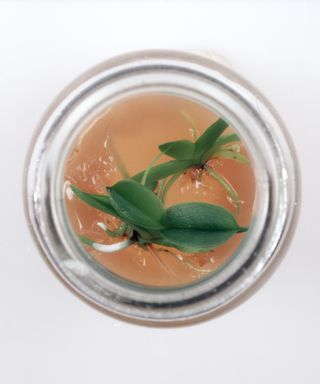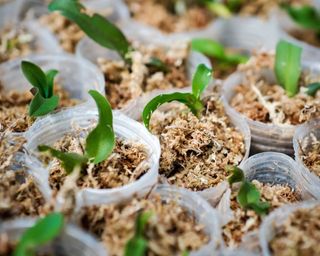Learning how to propagate orchids is a fun and inexpensive way to grow your houseplant collection. There are a number of tried and tested techniques that will help you produce more of your favorite plants or grow beautiful gifts. However, there is no one-size-fits-all solution.
Orchids are an incredibly large group of plants, comprising some 28,000 identified species in over 800 genera. The best method for propagating orchids varies by species – each has a few different ways of reproducing.
In home gardening, orchids are usually propagated vegetatively, through cuttings or division. They can also be grown from seed under certain conditions – but this can be a slow process.
Proper orchid care is essential to nurture both the young plants and the mother plant, which must be healthy in order to produce new plants.

(Image source: Alamy)
What kind of orchid?
Although there are many different types of orchids, they only have two main growth patterns: monopodial or bipodial. Before you start propagating, you need to know which type you have.
- Monopodial plants have a single root system that cannot be divided. They are usually propagated by keikis, which are plantlets that grow from flowering stems. However, some growers have had success with cuttings.
- Herbaceous plants produce pseudobulbs, similar to rhizomes, and can be separated and planted individually in a new pot.
In this article we will introduce the main orchid propagation methods suitable for each different orchid species.

(Image source: Getty Images)
1. Divide the pseudobulbs
Sympodial orchids develop pseudobulbs – green, swollen growths at the base of the plant that form on lateral or terminal rhizomes. The bulbs retain water and nutrients, acting as a storage unit during dry weather.
Each pseudobulb has the potential to become a new plant, and dividing them is a fairly easy way to grow your orchid collection. It is also the quickest solution because the small plant will already have roots and can start growing in its own pot.
Examples of orchids commonly grown with pseudobulbs include Cattleya, Oncidium, Dendrobium, Epidendrum and Laela. Unfortunately, this is not a suitable method for propagating orchids that do not have pseudobulbs, such as the very popular Phaeleonopsis.
Do not harvest pseudobulbs from orchids unless your plant is mature and healthy.
- Remove the plant from its growing medium and look closely at the roots. If the plant has been stuck in the pot for a long time, the roots may be tightly entangled and will need to be gently separated.
- Locate the pseudobulbs along the main stem and identify your sections. You will want to make sure each section has 2-4 pseudobulbs.
- Use sterilized pruning shears or a sharp knife to cut off those sections.

(Image source: Alamy)
- Many gardeners recommend sprinkling fungicide powder on the splits to prevent disease. Cinnamon is an effective natural fungicide.

(Image source: Alamy)
- Plant the divided cuttings in pots filled with fresh orchid potting mix.
- The shoots will grow fresh within a month or two and the new plant will flower the following year.

(Image source: Alamy)
2. Encourage Keikis
Some orchids produce keikis – which means “children” in Hawaiian. They are offshoots or offshoots of the mother plant. Growing keikis is one of the easiest methods of orchid propagation.
Dendrobium, Phalaenopsis, Oncidium and Epidendrum orchids can all produce keiki. These baby orchids can be encouraged to form by cutting back a dead stem. This encourages a second stem to develop. Keiki initially look like a flower spike, but they will soon develop leaves and secondary roots.
If they remain on the plant, the mother plant will be stressed from transferring energy to this new growth, so if you spot keiki, it is best to pull them out and repot the plant.
- To encourage keiki flowering, cut the wilted stem above the node and move the plant to a slightly dimmer light location.

(Image source: Alamy)
- Over time, keikis will form. Move the main plant back to normal light and wait until the keikis have 2-3 roots.

(Image source: Getty Images)
- Cut off the middle part of the stem and the orchid flower with a sharp, sterilized tool.

(Image source: Alamy)
- Plant each seedling separately in its own pot and care for it just like the mother plant.

(Image source: Alamy)
Like pseudobulbs, keiki plants are instant pot plants and just need time to acclimate to their new pots and grow steadily.
3. Growing orchids from cuttings
There is some controversy about this method, as many gardeners have tried and failed to grow orchids from cuttings. However, others swear by it, and you have nothing to lose by trying.
Vanda and Phalaenopsis orchids can be grown from cuttings.

(Image source: Getty Images)
- Cut a keiki stem 10 inches (25cm) long, cutting just above a leaf node.
- Cut the stem into sections, each section having at least 2 growing nodes.
- Apply cinnamon powder, activated charcoal or anti-fungal powder to the cut end.
- Place the stem horizontally in a tray of moist sphagnum moss.
- Cover the tray with a plastic bag or plastic wrap and place the container in indirect sunlight.
- Monitor the cuttings and make sure there is adequate humidity in the container and the moss stays moist.
- Some orchids will root within a month but others take many months.
- Once the cutting has developed enough roots, it is time to transfer it to a new pot. Use the same medium as the mother plant and care for the new plantlet in the same way, under the same temperature and light conditions.
4. Propagating orchids from seeds
This is where things get tricky. Growing orchids from seed requires specialized conditions and a sterile environment. This takes a lot of effort for the home grower, but it can be done with patience.
You can try this method with any orchid seed, but growing rare varieties has a special appeal. Keep in mind that it can take several years for orchids grown from seed to bloom.
The method of germinating at home is called abiotic germination or seed incubation. The seeds will be placed in a clear jar in a jelly-like substance.
You can buy pre-made agar or make your own using agar powder and hot water. To mix, boil 3.4oz (100ml) of water and add 0.8oz (25g) of agar powder. Stir the powder well.
- First, you need to harvest the seeds from the orchid pot. Before doing this, place the fruit in a container with a little bleach and let it sit for 15-20 minutes.
- Using a sterilized scalpel and tweezers, open the shell and remove the seeds. Place the seeds in a sterile jar.

(Image source: Alamy)
- Pour 3% hydrogen peroxide into the jar, close the lid and shake to coat the seeds evenly.
- Place the jar in a bright place for a few hours.
- Disinfect the area you will be working in with bleach.
- If possible, use a glove box to ensure a sterile environment for the seeds. If not, it is important to thoroughly disinfect your work surface and surrounding objects.
- Wash hands and forearms and put on sterile gloves.
- Spray bleach inside the plastic bag.
- Mix a few drops of hydrogen peroxide with 3.4oz (100g) of agar into the seed jar.
- Place the jar inside a plastic bag and place the sealed jar in a bright place.
- Some orchids will germinate fairly quickly, while others may take months. Check the pot regularly.

(Image source: Alamy)
- Prune crowded orchids as they grow.
- When roots appear, each seedling needs to be transplanted into a new container of agar.

(Image source: Alamy)
- Finally, young orchids can be repotted into containers filled with orchid potting mix. Avoid doing this until the seedlings are large enough to handle. Before potting, rinse the agar with distilled water.

(Image source: Shutterstock)
